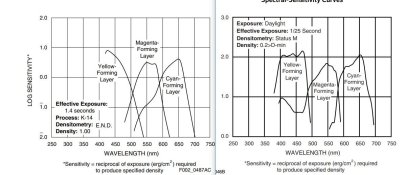The thing that might make it appear to look like KC when reversed in E6 is probably it’s propensity to develop a cyan cast in that chemistry. That counteracts the orange mask without completely nullifying it.
IE. KC had an apparent brownish, orangish cast.
But in other regards it’s not at all like KC.
Makes you wonder though, was the warming filter apparent in KC implemented with the same intent as the orange mask in colour negative?
That is, to help remove some of the uneven and overlapping response of the sensitizing dyes?
Edit: I realize that it’s reversal film and most things are opposite and weird, but an orange or equivalent mask or dye would work during the re-exposure stages of KC to correct colours.
Has anyone decrypted the KC patent?
IE. KC had an apparent brownish, orangish cast.
But in other regards it’s not at all like KC.
Makes you wonder though, was the warming filter apparent in KC implemented with the same intent as the orange mask in colour negative?
That is, to help remove some of the uneven and overlapping response of the sensitizing dyes?
Edit: I realize that it’s reversal film and most things are opposite and weird, but an orange or equivalent mask or dye would work during the re-exposure stages of KC to correct colours.
Has anyone decrypted the KC patent?
Last edited:







